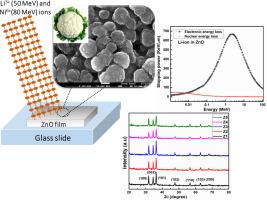50 MeV 锂离子和 80 MeV 镍离子诱导氧化锌菜花状结构发生变化:结构、光学和电学研究
IF 4.3
Q2 CHEMISTRY, PHYSICAL
引用次数: 0
摘要
这项研究采用共沉淀法合成了氧化锌,并与 0.5% 的聚乙烯醇混合制备薄膜。这些氧化锌薄膜分别用能量为 50 MeV 和 80 MeV 的锂(Li)和镍(Ni)光束以不同的通量进行辐照。XRD 图谱显示,与纯氧化锌相比,锂辐照氧化锌的晶粒大小从 41 纳米到 21 纳米不等,而镍辐照氧化锌的晶粒大小则为 16 纳米。紫外-可见光谱显示,锂离子辐照 ZnO 的带隙为 3.20 eV,而镍离子辐照 ZnO 的带隙则为 3.11 至 3.08 eV。然而,镍离子会导致缺陷随着通量的增加而增强。电学特性显示,两种离子辐照氧化锌后,电流都以三的顺序增强。锂离子辐照导致电阻率降低,而镍离子辐照则导致氧化锌电阻率升高。这表明,离子束诱导的氧化锌晶格改性可用于调整光电特性和amp;可用于有机发光二极管。本文章由计算机程序翻译,如有差异,请以英文原文为准。

50 MeV Li- and 80 MeV Ni- ions induced modification in ZnO cauliflower like structure: Structural, optical and electrical studies
In this work, ZnO has been synthesized by co-precipitation method and mixed with 0.5 % of polyvinyl alcohol for the preparation of thin film. These ZnO thin films have been irradiated with lithium (Li) and nickel (Ni) beams of energy 50 MeV and 80 MeV respectively, at different fluence. XRD pattern reveals that the crystallite size varies from 41 nm to 21 nm for Li-irradiated ZnO and to 16 nm for Ni irradiated ZnO compared to pure ZnO. From UV–Visible spectroscopy, the bandgap of Li-irradiated ZnO to a fluence of 5 × 1012 ions/cm2 is found to be 3.20 eV However, for Ni-irradiated ZnO bandgap varies from 3.11 to 3.08 eV Upon investigation of PL spectra, it has been observed that broadening in the defect region is observed on increasing the Li fluence. However, Ni-ions lead to enhancement of defects with increase in fluence. Electrical properties reveal the enhancement of current in order of three for both the ions irradiated ZnO. Li irradiation leads to reduction in resistivity whereas Ni irradiation leads to the enhancement in ZnO resistivity. This suggests that the ion beam induced modification in ZnO lattice could be useful for tuning the optoelectronic properties & can be used for organic light emitting diodes.
求助全文
通过发布文献求助,成功后即可免费获取论文全文。
去求助
来源期刊

Chemical Physics Impact
Materials Science-Materials Science (miscellaneous)
CiteScore
2.60
自引率
0.00%
发文量
65
审稿时长
46 days
 求助内容:
求助内容: 应助结果提醒方式:
应助结果提醒方式:


